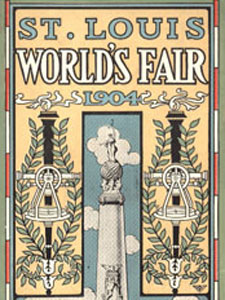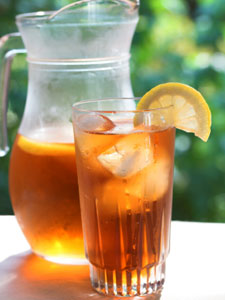The Coolest Tea: Iced Tea


Now that we've blazed through a number of hot subjects with tea, let's cool off. This lesson will cover one of the coldest aspects of Camellia sinensis: iced tea.
a The origin of iced tea, if not entirely accurate, is at least refreshing. The story goes like this: By 1904, America stabilized her government, strengthened her economy, and expanded her borders and interests. The United States was now ready for the world to see her development at the St. Louis World's Fair.
Trade exhibitors from around the world brought their products to America's first World's Fair. One such merchant was Richard Blechynden, an English tea plantation owner. Originally, he had planned to give away free samples of his hot tea to attendees. But when a heat wave hit, no one was interested. Parched from the temperature, visitors would pass his booth in search of a cooler refreshment. To save his investment of time and travel, he dumped a load of ice into the brewed tea and served the first iced tea. It was (along with the Egyptian fan dancer) the hit of the Fair.
However, tea historians must acknowledge the fact that tea was often enjoyed at cooler temperatures in the South long before that. For similar (heat) reasons, tea was allowed to cool before serving (with ice if possible, but this was rare at the time due to lack of refrigeration technology). This was usually served with sugar (to taste), called Sweet Tea. Sweet tea, as our Southern constituents will attest, is still enjoyed to this day.
Unfortunately, contemporary iced tea has received a bum rap in the US. While more than 80% of tea's consumption in the US is in the form of iced tea, most of it is in a form that bears little resemblance to tea: syrupy, over-flavored, stale and artificial beverages.
New ideas in iced tea are on the horizon. Instead of using loads of sugar and artificial flavor, this new tea movement retraces its steps to simple, pure, delicious tea. Thanks to the abundant availability of quality tea and good water, you can make a refreshing, healthy beverage... an Iced Tea worthy to be called Tea.
Although the popular standard for iced tea is usually black tea (typically a low-quality Ceylon or cheap, vaguely-labeled "China tea"), any tea can be "iced." Next time you thirst for a frosty glass of tea, reach for something different: great iced teas can be made from Black, Oolong, Green, White, and even Pu'erh.
Yet another idea for iced tea is not actually a tea at all, rather an Iced Tisane (or herbal beverage). Building upon the renewed popularity iced tea has recently enjoyed, many companies are shying away from the seemingly flooded iced black tea market, turning instead to non-caffeinated, but equally delicious, herbals. New beverages, such as Iced Red (Rooibos) "tea," Iced Ginger "tea" and Iced Mint "tea," provide a perfect alternative for the caffeine-sensitive (or those who are just trying to get some sleep).
It is very easy to make iced tea, and made from real leaves, it tastes great. To make a cup, simply double the amount of tea leaves (usually making it two teaspoons per cup of water), and steep as usual. Once tea is ready, dilute with an equal amount of ice. Garnish with mint or lemon and enjoy its great taste. Some teas, particularly tippy black teas, will cloud when iced quickly. This is just visual and won't affect the flavor. To prevent clouding, dilute your double-strength brewed tea with cool water instead, and serve over ice only when you're ready to enjoy it. If making iced tea for a group of friends, keep your serving pitcher at room temperature, adding ice to your drinking glasses. Refrigeration dulls the flavor, while adding ice to a big pitcher of tea will water it down over the afternoon. Enjoy within 12 hours of brewing. Ahh! Refresh and repeat!
Any way you brew it, the most important thing to remember when making iced tea is quality. For the best iced tea, you'll need the best tea.
Stay cool and drink deep.
 teaclass
teaclass
